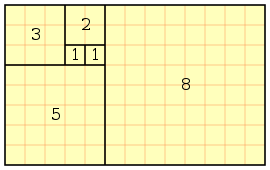Math: Fibonacci numbers
The Fibonacci spiral
In mathematics, the Fibonacci numbers are a sequence of numbers named after Leonardo of Pisa, known as Fibonacci (a contraction of filius Bonaccio, "son of Bonaccio"). Fibonacci's 1202 book Liber Abaci introduced the sequence to Western European mathematics, although the sequence had been previously described in Indian mathematics.
Here is an example:
The first number is 0; the second number is 1.
0 + 1 = 1
1 is the third number.
1 + 1 (The previous number) = 2
2 is the fourth number.
1 + 2 = 3
3 is the fifth number.
2 + 3 = 5
5 is the sixth number.
The sequence created is:
0 1 1 2 3 5
The next number is 8.
Here is a chart.

Each side length of a square is a Fibonacci number.
Uses
The Fibonacci number series is used for optional lossy compression in the IFF 8SVX audio file format used on Amiga computers.
The Fibonacci numbers occur in the sums of "shallow" diagonals in Pascal's triangle and Lozanić's triangle (see "Binomial coefficient").
These are only two there are more.
In Nature

Sunflower showing pattern in seed layout
Fibonacci sequences appear in biological settings, in two consecutive Fibonacci numbers, such as branching in trees, arrangement of leaves on a stem, the fruitlets of a pineapple, the flowering of artichoke, an uncurling fern and the arrangement of a pine cone. In addition, numerous poorly substantiated claims of Fibonacci numbers or golden sections in nature are found in popular sources, e.g. relating to the breeding of rabbits, the spirals of shells, and the curve of waves. The Fibonacci numbers are also found in the family tree of honeybees.
Sources:
Wikipedia




0 comments:
Post a Comment